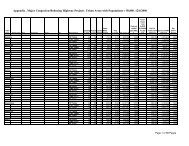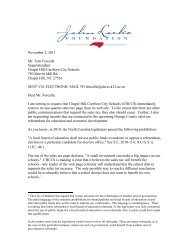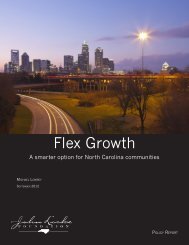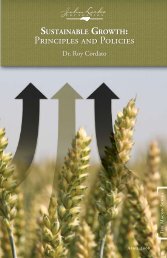A North Carolina Citizen's Guide to Global Warming - John Locke ...
A North Carolina Citizen's Guide to Global Warming - John Locke ...
A North Carolina Citizen's Guide to Global Warming - John Locke ...
Create successful ePaper yourself
Turn your PDF publications into a flip-book with our unique Google optimized e-Paper software.
A N o r t h C a r o l i n a C i t i z e n ’ s G u i d e t o G l o b a l Wa r m i n g<br />
<br />
For example, higher sea-surface temperatures provide<br />
more of the energy that fuels hurricane winds.<br />
Sea-surface temperatures have indeed been increasing<br />
as the Earth has warmed, exactly as would be<br />
expected. 32<br />
On the other hand, vertical wind shear and<br />
vertical stability also affect hurricane intensity.<br />
Vertical wind shear is the variation of wind speed<br />
with altitude. Vertical stability is the propensity of<br />
air masses <strong>to</strong> mix vertically (lower vertical stability<br />
means more mixing). Climate models predict that<br />
greenhouse warming would act <strong>to</strong> increase both<br />
vertical wind shear and vertical stability. 33 Both of<br />
these changes would decrease hurricane intensity.<br />
Observations in the tropical Atlantic show<br />
that the real atmosphere is behaving just the opposite<br />
of greenhouse warming predictions. Since<br />
the 1970s, vertical wind shear and vertical stability<br />
have been decreasing. 34 Both of these trends<br />
would tend <strong>to</strong> increase the number and intensity<br />
of hurricanes—exactly what has been observed<br />
in the Atlantic. 35 We are thus in the ironic situation<br />
where the reason for the increase in Atlantic<br />
hurricanes during the last decade may be that the<br />
atmosphere is behaving opposite <strong>to</strong> what would be<br />
expected under greenhouse warming.<br />
Claim: Climate change is the cause of the increasing<br />
financial losses from hurricanes.<br />
Reality: Most of the people who live along the<br />
coast in hurricane-prone areas of the U.S. have<br />
moved there since 1960. 36 The rapid increase in<br />
the number of people—and their buildings and<br />
property—in hurricane-prone coastal areas guarantees<br />
that hurricane losses will increase over time,<br />
even if there is no change, or even a decrease, in<br />
the number or destructiveness of hurricanes. 37 If<br />
you estimate the financial losses that would have<br />
occurred if past hurricanes had hit <strong>to</strong>day’s coastal<br />
infrastructure, you find that there has been no<br />
trend from 1900 <strong>to</strong> 2005 in hurricane destructiveness,<br />
and six of the ten most destructive hurricanes,<br />
including the most destructive one, hit<br />
before 1950. 38<br />
Scary claims of increasing hurricane devastation<br />
are one of the main weapons in climate<br />
alarmists’ arsenal. Activists were quick <strong>to</strong> blame<br />
Hurricane Katrina on global warming. As Al Gore<br />
puts it in An Inconvenient Truth, “And then came<br />
Katrina … the consequences were horrendous.<br />
There are no words <strong>to</strong> describe them.” 39 Ironically,<br />
Katrina was only a Category 3 hurricane (where<br />
1 is weakest and 5 is strongest) by the time it hit<br />
New Orleans.<br />
Hurricane Katrina’s devastation is a tale of<br />
human-caused damage. But it doesn’t have anything<br />
<strong>to</strong> do with climate change. Rather, Katrina<br />
is a s<strong>to</strong>ry about government subsidizing people<br />
<strong>to</strong> live in risky areas and failing <strong>to</strong> build adequate<br />
defenses against s<strong>to</strong>rms that were guaranteed <strong>to</strong><br />
arrive eventually, with or without human-caused<br />
warming. 40<br />
Data for N.C.’s coast show that average<br />
sea level has dropped a few inches below<br />
peak levels achieved during the 1990s<br />
and is now about the same as peak levels<br />
during the 1940s and 1970s.<br />
Claim: Human-caused global warming is causing<br />
dangerous increases in sea levels and may wipe out<br />
<strong>North</strong> <strong>Carolina</strong>’s coastal areas.<br />
Reality: Climate activists in <strong>North</strong> <strong>Carolina</strong> have<br />
been claiming that greenhouse warming will flood<br />
the Outer Banks and wipe out the state’s coastal<br />
areas. 41 But data for <strong>North</strong> <strong>Carolina</strong>’s coast show<br />
little sea-level rise during the last few decades.<br />
Wilming<strong>to</strong>n has the longest-running series of sealevel<br />
measurements for <strong>North</strong> <strong>Carolina</strong>, covering<br />
the years from 1936 <strong>to</strong> 2005 (see Figure 2). Average<br />
sea level has risen only about 5 or 6 inches during<br />
this 70-year period. Furthermore, for the last<br />
five years, average sea level has actually dropped a<br />
few inches below peak levels achieved during the<br />
1990s and is now about the same as peak levels<br />
during the 1940s and 1970s. There doesn’t seem <strong>to</strong><br />
be much of a global warming signal in the <strong>North</strong><br />
p o l i c y r e p o r t










